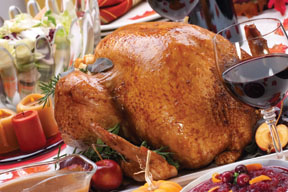| << Back |
The Wine Cellar: Hooray for Beaujolais
By Gordon Gilbert
The holidays are almost upon us, and with them comes the almost certain possibility of classically heavy and rich feasts. No doubt we will experience our fair share of roasted turkey, stuffing, sweet potatoes, cranberry sauces and hams of all glazes. So what wine might pair best with the food and festivities of the season? Beaujolais.
Located south of Burgundy in France, Beaujolais is commonly associated with red wine, though there are white and rose wines made in this region as well. It is the red wines derived from the Gamay grape that deserve our strongest attention, as they offer a flavorful counterpart to all the rich fare presented before us.
Unfortunately, Beaujolais has had its image tarnished over the years by its tradition of rolling out wines on the third Thursday of November after harvest. This Beaujolais Nouveau, primarily made with grapes from the clay-rich soils found in the southern portion of the region, is low in quality and depends on a process called carbonic maceration. The process yields wines that have very distinctive banana peel and strawberry bubblegum flavor.
In the granite rich north, however, you will find the ten crus of Beaujolais. The ten crus are sub regions within Beaujolais that are mostly centered around a village with the same name. They are as follows: St-Amour, Juliénas, Chénas, Moulin-a-Vent, Fleurie, Chiroubles, Morgon, Régnié, Côte de Brouilly, Brouilly. Wines from these crus are richer, fuller in body, and decidedly more complex than others from the region. When you see these wines on your retail shelf, they will be labeled not as Beaujolais, but by their own specific cru. Beaujolais Nouveau, the ones we advise you ignore, will often be labeled as simply Beaujolais.
Abbreviated Tour of the Ten Crus
Starting with the southernmost cru, Chateau de La Chaize Brouilly 2008 ($14/btl.) is a wine of fantastic elegance. The light-bodied wine has a soft ruby color and delicate, fragrant aromas. It has notes of fresh strawberry and carnations on the palate, making it a perfect complement to poultry with cranberry compote. Perhaps its elegance is due in part to the fact that the architects of the estate buildings also designed the palace at Versailles.
As we move north we arrive in Morgon. Here, Domaine des Versauds Morgon 2009 ($14/btl.) offers a slightly heavier, yet still medium-bodied counter to the wines of Brouilly. This wine presents red cherry on the nose and palate, along with lingering notes of wild flowers. There is also a slight chocolate note that contributes a touch of sweetness. Perfect for pairing with candied yams or sweet potatoes.
About two kilometers north lies Fleurie, home of Chateau des Deduits Fleurie 2009 ($18/btl.). While still being light in body and having the unmistakable touch of wildflowers that Gamay can be trusted to provide, darker fruit is prevalent here. You will experience black cherry, hints of tea and a subtle array of spice that simply shouts to partner with stuffing.
Domaine des Michelons Moulin-a-Vent 2009 ($18/btl.) completes our tour of the Beaujolais crus. There is a strong sense of violets and cassis on the nose that is repeated wonderfully on the palate, with marionberry and boysenberry coming along for the ride. With subtle oak notes and engaging acidity, this wine makes an ideal match for roasted turkey.
The holidays may come and go, but memories of joyous gatherings ‘round the table last forever. Indulge in sweet treats and rich foods with abandon, and raise your glasses in a toast to the many blessings of the season.
Gordon Gilbert holds wine certifications from the Court of Master Sommeliers, Society of Wine Educators and the Culinary Institute of America. He has worked the floor as a sommelier for ten years and is currently pursuing his Master Sommelier certification. He can be reached at elgordo43@hotmail.com.








